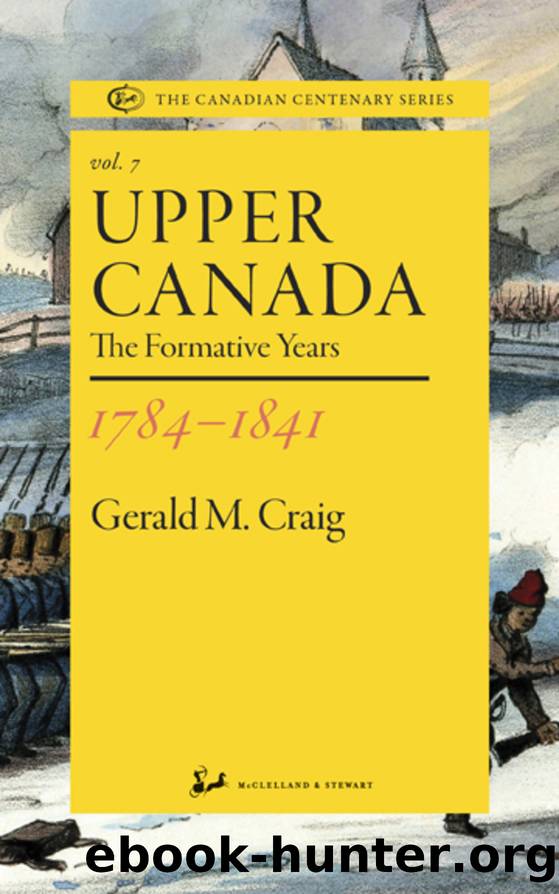Upper Canada 1784-1841 by Gerald M. Craig

Author:Gerald M. Craig [Craig, Gerald M.]
Language: eng
Format: epub
Publisher: McClelland & Stewart
Published: 2016-09-27T00:00:00+00:00
A Canada Company map of the western part of the province, 1828
While action on this legislation was awaited, the first Canadian bank had already opened its doors. In 1817 the Bank of Montreal began to do business as a private assocation, some five years before the legislation incorporating it was formally proclaimed. This bank, like other Canadian banks to follow it, was closely modelled on the Bank of the United States established at Alexander Hamiltonâs urging in 1791, and which in 1816 had just been revived as the Second Bank of the United States. Hamilton in turn had derived his banking principles from English and Scottish models. Here, then, was an instance of Canada receiving a British institution after it had been adjusted and modified to North American conditions in the United States.
Meanwhile, the Kingston merchants, still waiting for the confirmation of their charter, also began operation as a private association at the beginning of 1819; this move was doubtless stimulated by the fact that the Bank of Montreal was extending its operations into Upper Canada. Soon afterward word came that the Bank Act of 1817 had been approved, but by this time the legislation had expired because of a two-year time limit. It was apparently simply a matter of re-enacting it, in the sure knowledge that it was acceptable to the British government. A bit of sleight-of-hand now occurred, however, by which a bank was established at York, not at Kingston.
In fact, an attempt had already been made to start a bank at York when a petition headed with the name of the Reverend John Strachan had been submitted to the Assembly in 1817 some days after the Kingston petition. The Assembly, which probably doubted that the petitioners represented any very considerable accumulation of financial power, failed to act on the petition. In 1819, however, Maitland, who was undoubtedly influenced by Strachan and his associates, informed London that the Kingston group were an untrustworthy lot with dangerous American connections. The only safe bank would be one with close government ties, and with headquarters at York.26 Accordingly, the charter was taken away from the Kingston group, and a bill passed establishing the Bank of Upper Canada. To be sure, a bill was also passed chartering the Kingston group, but on terms which they could not meet. In consequence, they continued as a private association into the early 1820âs, when a combination of bad luck and bad management forced them to default. It was the first Canadian bank failure.
The Bank of Upper Canada, whose charter was not finally confirmed until 1821, had very close connections with the provincial government, on the model of the First and Second Banks of the United States. One-quarter of the stock was to be subscribed by the government, which was also to appoint four of the fifteen directors. Branch offices on the Hamiltonian model were also expressly allowed. The government immediately subscribed its share, but it proved to be impossible to raise the remainder of the required minimum among private subscribers.
Download
This site does not store any files on its server. We only index and link to content provided by other sites. Please contact the content providers to delete copyright contents if any and email us, we'll remove relevant links or contents immediately.
| Africa | Americas |
| Arctic & Antarctica | Asia |
| Australia & Oceania | Europe |
| Middle East | Russia |
| United States | World |
| Ancient Civilizations | Military |
| Historical Study & Educational Resources |
The Bomber Mafia by Malcolm Gladwell(1183)
Submerged Prehistory by Benjamin Jonathan; & Clive Bonsall & Catriona Pickard & Anders Fischer(1162)
Facing the Mountain by Daniel James Brown(1135)
The Dawn of Everything by David Graeber & David Wengrow(1111)
The Way of Fire and Ice: The Living Tradition of Norse Paganism by Ryan Smith(1033)
Wandering in Strange Lands by Morgan Jerkins(1018)
Driving While Brown: Sheriff Joe Arpaio Versus the Latino Resistance by Terry Greene Sterling & Jude Joffe-Block(1003)
Tip Top by Bill James(1002)
Evil Geniuses: The Unmaking of America: A Recent History by Kurt Andersen(1001)
Red Roulette : An Insider's Story of Wealth, Power, Corruption, and Vengeance in Today's China (9781982156176) by Shum Desmond(1000)
F*cking History by The Captain(969)
It Was All a Lie by Stuart Stevens;(941)
White House Inc. by Dan Alexander(906)
Evil Geniuses by Kurt Andersen(903)
Treasure Islands: Tax Havens and the Men who Stole the World by Nicholas Shaxson(880)
American Dreams by Unknown(859)
American Kompromat by Craig Unger(849)
The Fifteen Biggest Lies about the Economy: And Everything Else the Right Doesn't Want You to Know about Taxes, Jobs, and Corporate America by Joshua Holland(817)
The First Conspiracy by Brad Meltzer & Josh Mensch(812)
